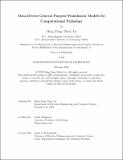| dc.description.abstract | The field of computational pathology has undergone a remarkable transformation in recent years. Researchers have leveraged supervised and weakly-supervised deep learning with varying degrees of success to address a wide range of tasks, including cancer subtyping and grading, metastasis detection, survival and treatment response prediction, tumor site-of-origin identification, mutation prediction, biomarker screening, and more. However, traditional task-specific models often require extensive labeled data and struggle to generalize across diverse pathology tasks. This limitation motivates the exploration of foundation models, which promise a more scalable, versatile solution by learning broad representations that can be adapted to various downstream applications. In this thesis, I will investigate the capabilities and limitations of data-driven foundation models in computational pathology. Specifically, I will explore two frameworks for developing general-purpose encoder models for pathology images: one using paired image-text data, and another leveraging self-supervised learning on large-scale unlabeled images. Additionally, I will examine downstream applications of these foundation models, including zero-shot transfer to gigapixel whole slide images and the development of an interactive multimodal AI assistant for pathologists. | |
